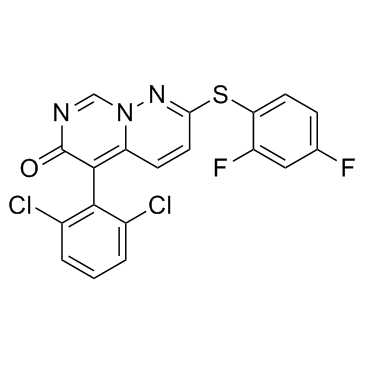209410-46-8
| Name | 5-(2,6-dichlorophenyl)-2-(2,4-difluorophenyl)sulfanylpyrimido[1,6-b]pyridazin-6-one |
|---|---|
| Synonyms |
vx-745
VX 745 VX745 UNII:TYL52QM320 Neflamapimod 6H-Pyrimido(1,6-b)pyridazin-6-one, 5-(2,6-dichlorophenyl)-2-((2,4-difluorophenyl)thio)- 6H-Pyrimido[1,6-b]pyridazin-6-one, 5-(2,6-dichlorophenyl)-2-[(2,4-difluorophenyl)thio]- 5-(2,6-Dichlorophenyl)-2-[(2,4-difluorophenyl)sulfanyl]-6H-pyrimido[1,6-b]pyridazin-6-one 5-(2,6-dichlorophenyl)-2-((2,4-difluorophenyl)thio)-6h-pyrimido(1,6-b)pyridazin-6-one |
| Description | Neflamapimod (VX-745) is a potent and selective inhibitor of p38α, and possesses anti-inflammatory activity. |
|---|---|
| Related Catalog | |
| In Vitro | Neflamapimod (VX-745) exhibits PBMC IL-1β and TNFα IC50 values of 45 and 51 nM, respectively. Neflamapimod is also effective in whole blood, blocking IL-1β and TNFα release with IC50 values of 150 and 180 nM, respectively. Neflamapimod shows a promising selectivity profile, with 20-fold selectivity for p38α over p38β (Ki=220 nM)[1]. Neflamapimod (VX-745) solutions in DMSO/DMEM inhibits the IL-6 production with IC50 of 15±9 nM[2]. Neflamapimod (VX-745; 5.0 nM) displays potent activity and 1000-fold selectivity over closely related kinases, including ERK1, JNK1-3 and MK2. Neflamapimod (10 nM-50 μM) increasingly inhibits the anisomycin-induced activity of p38α[3]. Neflamapimod (VX-745; 0.06 μM-20 μM) inhibits IL-6 and VEGF secretion in BMSCs. Neflamapimod can inhibit cytokine (TNF-α, IL-6, VEGF)-induced paracrine MM cell growth, survival, and drug resistance in the BM microenvironment. Neflamapimod induces modest growth inhibition of MM.1S, RPMI8226, and U266 cell lines in a dose-dependent fashion, with inhibitory concentration of 50% (IC50) of 10 μM[4]. |
| In Vivo | Neflamapimod (VX-745; 2.5, 5, and 10 mg/kg) improves the inflammatory scores in mice by 27%, 31%, and 44%, respectively[1]. Neflamapimod (VX-745; 1.06 mg/kg) significantly decreases the inflammation score from 2.07±0.29 for the control group to 1.42±0.06[2]. |
| Kinase Assay | Neflamapimod inhibits p38α and p38β. The IC50 for the inhibition of these two p38 homologs are obtained by a spectrophotometric coupled-enzyme assay. A fixed concentration of enzyme (15 nM of p38α or p38β) is incubated with various concentrations of Neflamapimod in DMSO for 10 min. at 30°C in 0.1 M HEPES buffer, pH 7.5, containing 10% glycerol, 10 mM MgCl2, 2.5 mM phosphoenolpyruvate, 200 μM NADH, 150 μg/mL pyruvate kinase, 50 μg/mL lactate dehydrogenase, and 200 μM EGF receptor peptide. The reaction is initiated with 100 μM and 70 μM ATP for p38α and p38β assays, respectively. The decrease of absorbance at 340 nm is monitored to follow the rate of the reaction. IC50 is evaluated from the rate data as a function of the inhibitor concentration. |
| Cell Assay | For these experiments, cells are plated at a density of 60,000 cells/well in 96-well plates. Each condition is tested in triplicate or more. The following day, all particle suspensions, active substances or control solutions are freshly prepared, distributed and incubated for 24 h at 37°C. Then, supernatants are carefully discarded. To perform the MTT test, 50 μL of 0.1% MTT solution is added to each well for 3 h. Each well is then incubated for 1 h with 200 μL of dimethyl sulfoxide. Absorbance is measured at 595 nm. Reported results are expressed as the means±SD. |
| Animal Admin | Type II collagen-induced arthritis is established in male DBA/1 mice with a minor modification. 10-Week old male DBA/1 mice are immunized by two intradermal injections within a 3 week interval using 100 μL of an emulsion consisting of a 1:1 (v/v) mixture of chick type II collagen (200 μg in 10 mM acetic acid) and complete Freund's adjuvant. Following the booster immunization, the mice are left untreated for 2-3 weeks, and are randomized into five treatment groups after they exhibit focal carpal (wrist) swelling (level 2 arthritic severity score) in both front paws. The five treatment groups are: 1: water control, 10 mL/kg, p.o., bid, (n=14); 2: 100% propylene glycol (PG) vehicle control, 10 mL/kg, p.o., bid, (n=8); 3: Neflamapimod in PG, at 10 mg/kg, p.o., bid, (n=7); 4: Neflamapimod in PG, at 5 mg/kg, p.o., bid, (n=10); and 5: Neflamapimod in PG, at 2.5 mg/kg, p.o., bid, (n=11). Arthritic symptoms are scored every other day using a level 1 to level 5 scoring system. Paw inflammation begins with erythema at the wrist (level 1), progressing to focal swelling of the wrist (level 2), to complete swelling of the wrist (level 3), to complete swelling of wrist and palm (level 4), and finally to complete swelling of wrist, palm and fingers (level 5). The sums of the scores from both front paw scores are used for plotting disease progression curves. Mice are sacrificed on day 20 and paws are removed, sectioned sagitally, stained with hemotoxylin & eosin, and scored for inflammation. Histologically, wrist joint inflammation begins with an infiltration of the synovium into the joint space (level 1), progressing to joint cartilage erosion (level 2), to joint cartilage and bone erosion (level 3), and finally to erosion of cartilage and bone accompanied by pannus formation (level 4). |
| References |
| Density | 1.6±0.1 g/cm3 |
|---|---|
| Boiling Point | 578.9±60.0 °C at 760 mmHg |
| Molecular Formula | C19H9Cl2F2N3OS |
| Molecular Weight | 436.262 |
| Flash Point | 303.9±32.9 °C |
| Exact Mass | 434.981140 |
| PSA | 72.56000 |
| LogP | 4.79 |
| Vapour Pressure | 0.0±1.6 mmHg at 25°C |
| Index of Refraction | 1.692 |
| Storage condition | Store at -20°C |
| HS Code | 2933990090 |
|---|
| HS Code | 2933990090 |
|---|---|
| Summary | 2933990090. heterocyclic compounds with nitrogen hetero-atom(s) only. VAT:17.0%. Tax rebate rate:13.0%. . MFN tariff:6.5%. General tariff:20.0% |
